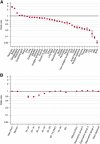Variation in 'fast-track' referrals for suspected cancer by patient characteristic and cancer diagnosis: evidence from 670 000 patients with cancers of 35 different sites
- PMID: 29182609
- PMCID: PMC5765227
- DOI: 10.1038/bjc.2017.381
Variation in 'fast-track' referrals for suspected cancer by patient characteristic and cancer diagnosis: evidence from 670 000 patients with cancers of 35 different sites
Abstract
Background: In England, 'fast-track' (also known as 'two-week wait') general practitioner referrals for suspected cancer in symptomatic patients are used to shorten diagnostic intervals and are supported by clinical guidelines. However, the use of the fast-track pathway may vary for different patient groups.
Methods: We examined data from 669 220 patients with 35 cancers diagnosed in 2006-2010 following either fast-track or 'routine' primary-to-secondary care referrals using 'Routes to Diagnosis' data. We estimated the proportion of fast-track referrals by sociodemographic characteristic and cancer site and used logistic regression to estimate respective crude and adjusted odds ratios. We additionally explored whether sociodemographic associations varied by cancer.
Results: There were large variations in the odds of fast-track referral by cancer (P<0.001). Patients with testicular and breast cancer were most likely to have been diagnosed after a fast-track referral (adjusted odds ratios 2.73 and 2.35, respectively, using rectal cancer as reference); whereas patients with brain cancer and leukaemias least likely (adjusted odds ratios 0.05 and 0.09, respectively, for brain cancer and acute myeloid leukaemia). There were sex, age and deprivation differences in the odds of fast-track referral (P<0.013) that varied in their size and direction for patients with different cancers (P<0.001). For example, fast-track referrals were least likely in younger women with endometrial cancer and in older men with testicular cancer.
Conclusions: Fast-track referrals are less likely for cancers characterised by nonspecific presenting symptoms and patients belonging to low cancer incidence demographic groups. Interventions beyond clinical guidelines for 'alarm' symptoms are needed to improve diagnostic timeliness.
Conflict of interest statement
The authors declare no conflict of interest.
Figures


References
-
- CRUK (2014) Safety netting recommendations for primary care. Retrieved from http://www.cancerresearchuk.org/health-professional/diagnosis/suspected-....
-
- Department of Communities and Local Government (2011) English Indices of Deprivation 2010. Retrieved from https://www.gov.uk/government/statistics/english-indices-of-deprivation-....
Publication types
MeSH terms
Grants and funding
LinkOut - more resources
Full Text Sources
Other Literature Sources

